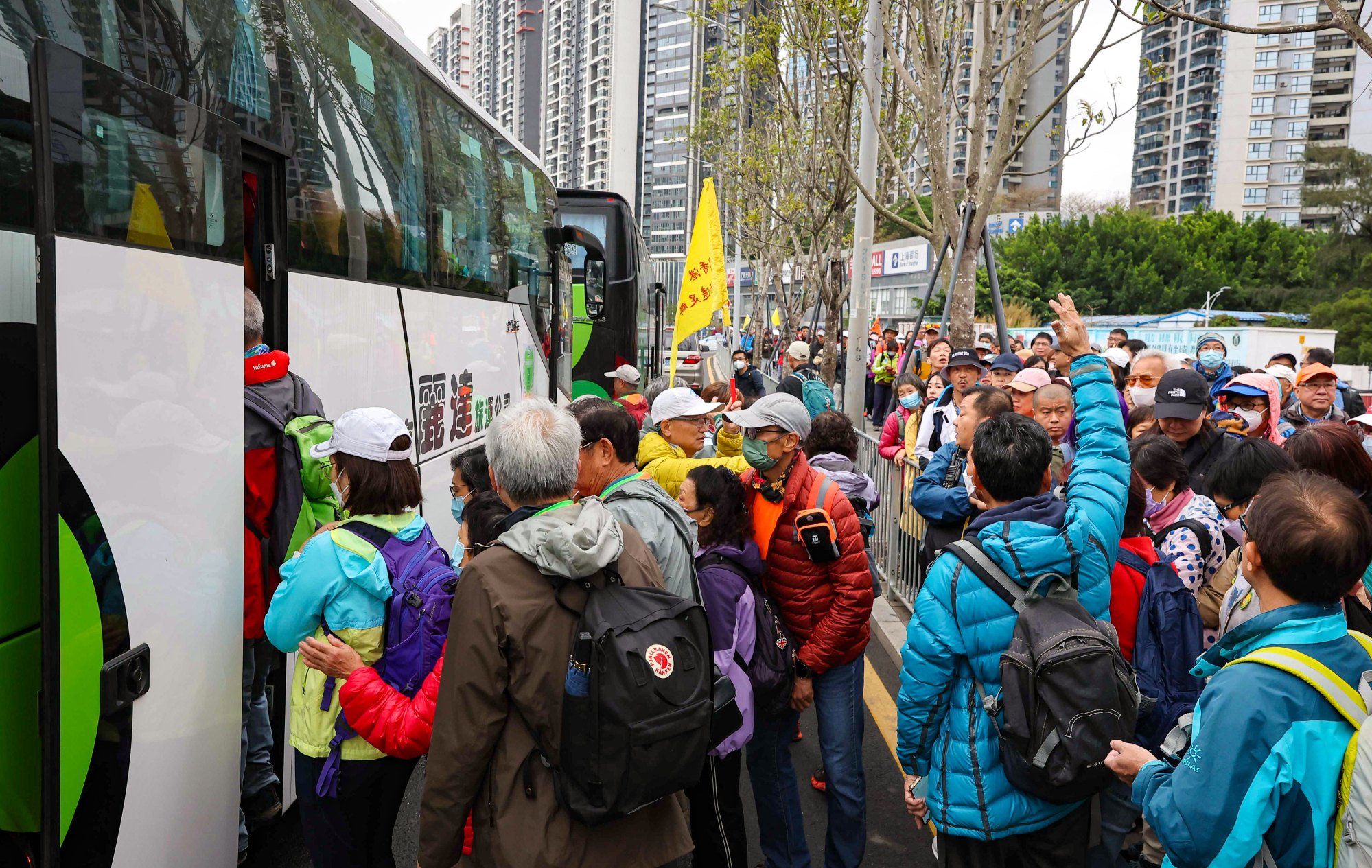
Hundreds of Hong Kong trekkers head to Shenzhen for free guided hike as part of cross-border activities aimed at boosting tourism
- Four hundred hikers from Hong Kong brave the rain to walk Shenzhen’s Kunpeng Trail, in 10th such event hoping to lure trekkers over to try local scenery
- Outdoor sports industry leader says he hopes new 208km Kunpeng hiking trails can encourage Hongkongers to ‘feel beauty of Shenzhen’s landscape’
About 400 hikers from Hong Kong braved the rain to gather at 9.30am near the cross-border checkpoint of Liantang Port in Shenzhen, before boarding coaches that brought them to the starting point at Yantian Shuangyong Park in half an hour.
Among them was Carmen Wong, who headed off from North Point at 6.45am to meet the team at the border crossing.
“I was invited by a friend, and this is my first time hiking in Shenzhen. I usually go to Shenzhen on weekends for food, karaoke and massages,” she said.
“I didn’t expect the rain. But it’s nice and safe to hike with a big group of people. I don’t need to worry about safety issues. If there are more opportunities like this, I will be more than happy to sign up again.”
Each hiker was also given a raincoat and free snack bag that included a waffle, an egg and some jelly before they started their 10km (6.2 miles) trek.

The hike covers scenic spots and paths such as the Provincial Greenway Line 2, Honghualing Reservoir and Yunhai Park. It was organised by Shenzhen municipality’s Culture, Radio, Television, Tourism and Sports Bureau, along with hiking associations both there and in Hong Kong.
The team began to divide into small groups at lunchtime, with some hikers choosing to take a bus to the park or leaving for the railway station.
Those who continued the hike arrived at a white, well-appointed hilltop building in the park around 2pm. Some bought hot coffee there and rested before a 30-minute walk downhill.
The full hike took about five hours and ended around 3.30pm. Only a small number of hikers walked the full trail.

“In general the hiking was nice, with facilities like restrooms, bus stations and supply depots along the way. But it is more like a countryside trail instead of a real, hardcore hiking trail for me,” said veteran hiker Chan Hon-tong, director of the China Hong Kong Mountaineering and Climbing Union.
Chan, who completed the full walk, said he wanted to try a different trail nearby with fewer concrete paths and staircases.
“The view of Yunhai Park is impressive and I believe it’s better when the weather is sunnier,” said Chan, adding that there was nowhere in Hong Kong where people could find an affordable, well-furnished coffee shop and library with a 360-degree panoramic view in the middle of a hike.
The hike is the 10th in a series of Shenzhen government-endorsed trekking activities this year aimed at attracting more Hong Kong tourists.
Lei Dongfeng, deputy director of the Shenzhen Mountaineering and Outdoor Sports Association, said the first hike on January 28 encouraged 170 Hongkongers to explore parts of the local Kunpeng Trail.

Nine more guided hikes in Shenzhen’s Yantian district have been organised since then, enjoying the support of local authorities and easy access from the border.
“At the end of last year, Shenzhen completed construction of the Kunpeng hiking trails from east to west, a total of 208km,” Lei said.
“In the past we would go to Hong Kong for the MacLehose Trail, now we want to attract Hong Kong hikers here to experience the beauty of Shenzhen’s landscapes.”
Economist Simon Lee Siu-po, who is also on a government advisory committee for tourism strategy, said Hong Kong had hiking groups too, but they were much smaller and often private.
“The government has to tackle a need for more transport and supporting facilities, otherwise, people may be dissatisfied and choose to shift [their hikes] to Shenzhen,” he said.
Lee added that local authorities’ efforts to promote hiking as a tourist activity were too discreet and scattered, saying that he only noticed a slight uptick in publicity after the Hong Kong Geopark, made up of sites in Sai Kung and the northeastern New Territories, was promoted to Unesco-grade status.
“The Tourism Board does its own thing, while the Agriculture, Fisheries and Conservation Department is doing other things separately,” he said.
Hong Kong authorities have faced a trend in residents heading north for leisure activities since borders fully reopened in February last year following the pandemic.
The city has struggled to bring back high-spending mainland Chinese visitors and locals are also leaving in droves for popular tourist destinations such as Japan and Shenzhen, where the Hong Kong dollar holds more value due to the weaker currencies there.
Hong Kong logged 745,000 visitor trips in the city in the first four days of the recent Lunar New Year holiday, while 1.3 million trips were taken by residents throughout the same period.
In his policy address in October, Chief Executive John Lee Ka-chiu vowed to revitalise tourism by developing a range of experiences, including tours based on national history, green ecology, traditional and pop culture, as well as nighttime activities.
A new government blueprint for Hong Kong’s tourism industry is expected to be revealed in the second half of this year.

